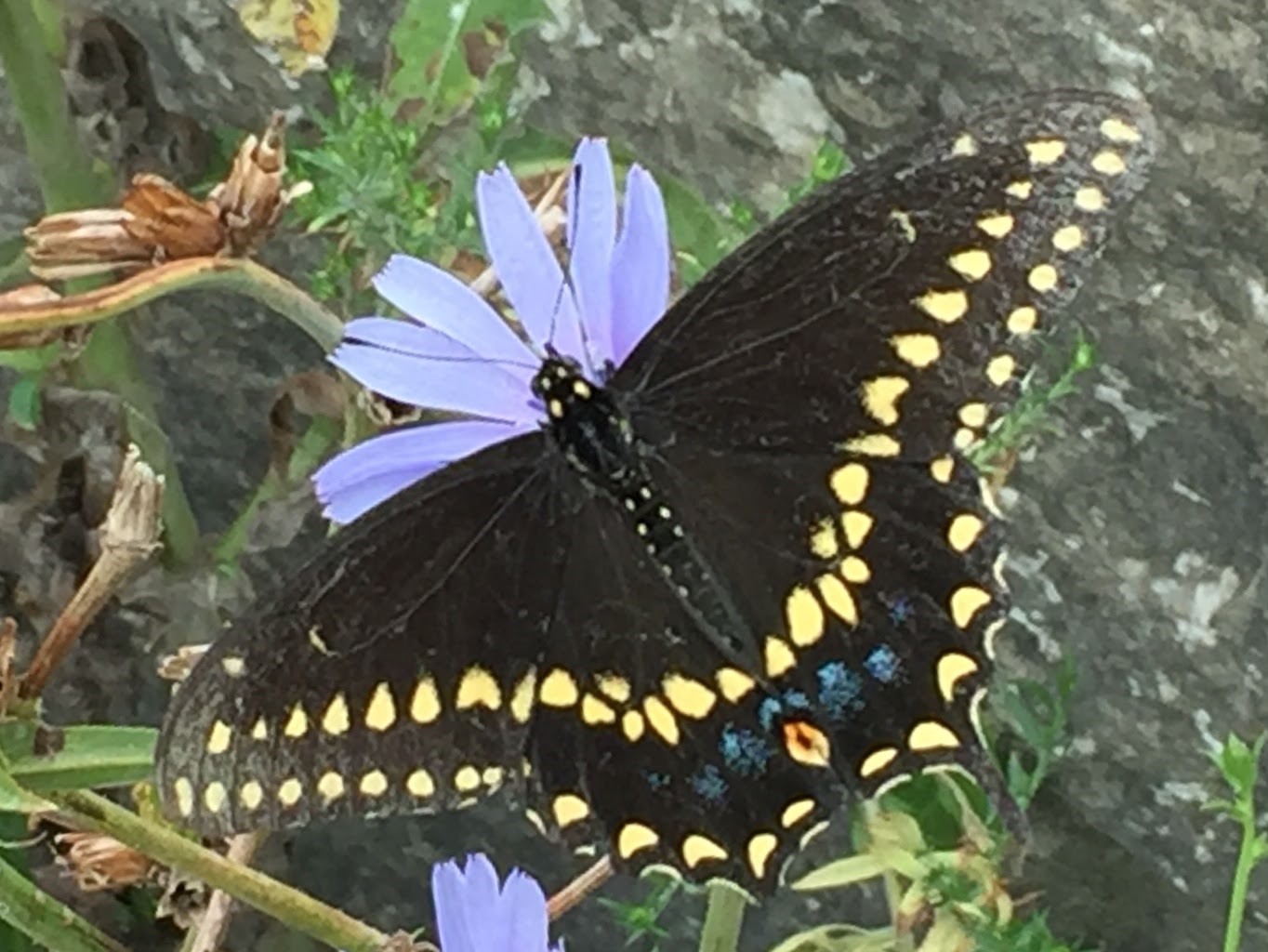Connected While Apart
Choices

Late Season Black Swallowtail (2019)
Dear Mayfield,
September is my favorite month of the year. I have always loved going back to school. I grew up in a setting where fall’s colors begin to get spectacular this month. My birthday’s in September. And at the time of the Fall Equinox, we move into the darker, quieter half of the year, at least by nature’s standards. The different rhythm of fall and winter has always been a welcome balance for me with the longer days, greater activity, and travel of spring and summer. I am not sure what that balance is going to feel like this year since the pandemic has uprooted and dismissed so many familiar rhythms and kept us closer to home, lightening our scheduled activity in every season.
Here on the cusp of summer and fall, there is still much to watch in the lives of our butterfly neighbors. The last generation of this year’s Monarchs are appearing among us, the super generation, the ones who will follow the ancient migration to Mexico, communally hibernate with thousands and thousands of others over the winter, and if they survive, begin the journey back north in the spring. Most species of butterflies do not undergo great seasonal migrations. So the curious among us might ask: What happens to all the other butterflies when we no longer see them darting in the air? The answer to that question is actually quite interesting.
Butterflies that do not winter-over by migration and who are responsible for the beginning of the generations who will follow them next year, make it through the winter variously. Butterflies are cold blooded animals, so as the earth cools, their body temperatures drop in accordance with their surroundings. Also, with the days growing shorter in autumn, they create natural antifreezes that mingle with their body fluids to keep ice crystals from forming in their cells. It is possible for different species of butterflies to safely hibernate in winter with their antifreezes as eggs, caterpillars, chrysalises and adult butterflies, in other words, in every cycle of their lives. Purplish coppers, a rare butterfly found in northern Illinois, spend the winter as eggs laid on leaves or twigs. A number of species including the Hackberry Emperor, pictured on our Web Note 46 (8.21.20) endure winter as caterpillars in clusters sheltering inside dead rolled leaves. Many Swallowtails like the Black Swallowtail above are in chrysalis during the winter. And there are about half a dozen Illinois butterflies, Morning Cloaks are one species of these, that winter as adults in the crevices of logs or beneath loose bark on trees. These are the butterflies seen on early warm spring days. They sometimes will come out during warm winter spells too. In our last Mayfield Nature Talk, Peggy described her delight when a Morning Cloak first appeared at Russell Woods as winter was edging toward spring. Delight or what Rainer Maria Rilke called our “astonished emotions” are an appropriate response to such seemingly small and vulnerable creatures braving a northern Illinois winter.
Learning more about butterflies, unseen but present in cold and harsh weather as eggs, caterpillars, chrysalises, and adults, makes me think about difficult situations we face. We don’t all deal in the same way with winter, or this pandemic, or heartbreaking economic realities, or complicated social issues, or the state of the climate and earth’s wellbeing, or the normal flow of loss in our lives. We are wise to pay attention to our own coping strategies, the healthy and the not so healthy ones. And in communication with one another, we can open up new ideas about how we might live beside what is so challenging right now. There isn’t just one pathway through to a new season of thriving. We can choose another route. If we find ourselves at a deadend, we might remember that the butterflies who bring us joy throughout the warm months are getting ready for winter in the particular manner that allows them to survive. From one species to another that manner is not the same. This isn’t an easy time by any stretch of the imagination. These days require internal resources, muscles of resilience, that we may not have even known we had. I suppose this is another expression of “We are in this together.” If that is the case, let us be aware of ourselves and of each other. And if we have found a new version of more-than-surviving in the present tense, we don’t have to be shy about sharing it. Our thriving might just work for someone else too.
Peace, Martha
Special Note — T.J.’s Memorial Time
There will be a memorial time celebrating the life of T.J. Lusher in the Mayfield Monarch Waystation at 11:00 am tomorrow, Wednesday, September 2, 2020 (her birthday). Please let Diana Swanson know if you are planning to attend, diana_swanson@comcast.net. In order to be ready for this celebration with a set up that honors appropriate social distancing and safe health practices, it will be helpful for us to know about numbers ahead of time. Those who are in attendance are asked to wear a mask.

